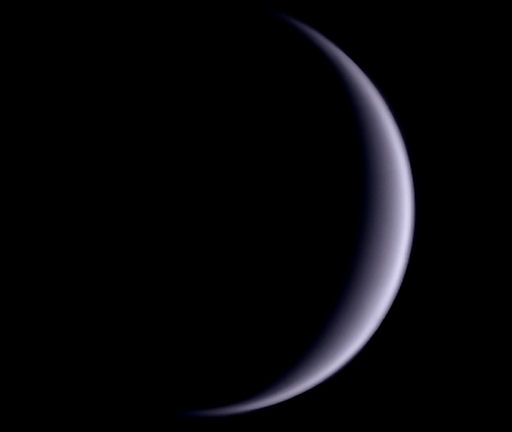VENUS TRANSFORMED: Something special is happening to Venus in the evening sky. The second planet is diving toward the sun for a much-anticipated transit on June 5-6. As Venus turns its night side toward Earth, the planet is transforming into a beautifully slender and colorful crescent:
John Chumack of Dayton, Ohio, took the picture on May 14th using a 10-inch telescope. "I was blown away by the sight of Venus," he says. "The planet was 14% illuminated, 47 arcseconds in diameter, and blazing at -4.43 magnitude."
The crescent shape of Venus is easy to see in good binoculars or small telescopes. No special observing experience is required. Just find Venus in the western sky after sunset (you can't miss it), point and look. A good tripod to hold the optics steady is recommended.
As the evening wears on and Venus sinks toward the horizon, the refractive effect of Earth's atmosphere splits the crescent into the colors of the rainbow. Kevin R. Witman of Cochranville, Pennsylvania, observed the phenomenon on May 11th: "Earth's atmospheric refraction of Venus's ample light made a beautiful image through my 10-inch telescope."
more images: from Sadegh Ghomizadeh of Tehran, Iran;

![]()
Solar wind
speed: 392.1 km/sec
density: 4.6 protons/cm3
explanation | more data
Updated: Today at 1657 UT
![]()
X-ray Solar Flares
6-hr max: C1 1226 UT May16
24-hr: C2 0921 UT May16
explanation | more data
Updated: Today at: 1600 UT
![]()
![]()
![]()
Daily Sun: 16 May 12
![]()
![]()
Previously active sunspot AR1476 continues to decay. Solar activity is low. Credit: SDO/HMI
![]()
![]()
![]()
Sunspot number: 125
What is the sunspot number?
Updated 15 May 2012
Spotless Days
Current Stretch: 0 days
2012 total: 0 days (0%)
2011 total: 2 days (<1%)
2010 total: 51 days (14%)
2009 total: 260 days (71%)
Since 2004: 821 days
Typical Solar Min: 486 days
Updated 15 May 2012
The Radio Sun
10.7 cm flux: 129 sfu
explanation | more data
Updated 15 May 2012
![]()
![]()
![]()
Current Auroral Oval:
![]()
Switch to: Europe, USA, New Zealand, Antarctica
Credit: NOAA/POES
![]()
![]()
![]()
Planetary K-index
Now: Kp= 2 quiet
24-hr max: Kp= 2 quiet
explanation | more data
![]()
Interplanetary Mag. Field
Btotal: 6.3 nT
Bz: 6.1 nT south
explanation | more data
Updated: Today at 1656 UT
![]()
![]()
![]()
Coronal Holes: 16 May 12
![]()
![]()
There are no large coronal holes on the Earthside of the sun. Credit: SDO/AIA.






Comments
SERVE ALL OF THIS! FIND A
SERVE ALL OF THIS! FIND A WAY....